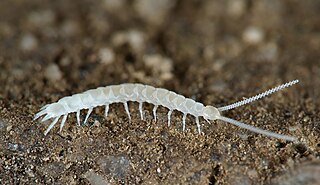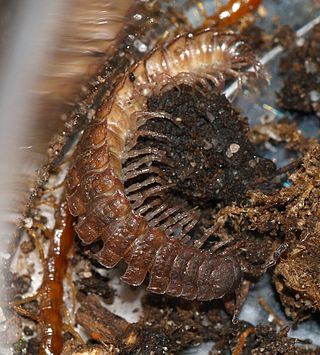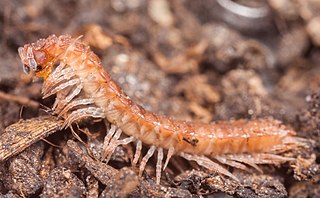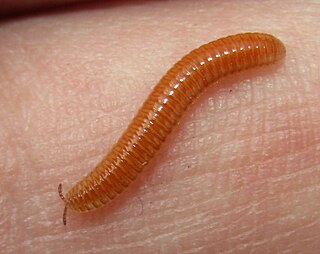
Millipedes are a group of arthropods that are characterised by having two pairs of jointed legs on most body segments; they are known scientifically as the class Diplopoda, the name derived from this feature. Each double-legged segment is a result of two single segments fused together. Most millipedes have very elongated cylindrical or flattened bodies with more than 20 segments, while pill millipedes are shorter and can roll into a tight ball. Although the name "millipede" derives from Latin for "thousand feet", no species was known to have 1,000 or more until the discovery in 2020 of Eumillipes persephone, which can have over 1,300 legs. There are approximately 12,000 named species classified into 16 orders and around 140 families, making Diplopoda the largest class of myriapods, an arthropod group which also includes centipedes and other multi-legged creatures.

Symphylans, also known as garden centipedes or pseudocentipedes, are soil-dwelling arthropods of the class Symphyla in the subphylum Myriapoda. Symphylans resemble centipedes, but are very small, non-venomous, and only distantly related to both centipedes and millipedes. More than 200 species are known worldwide.

Polydesmida is the largest order of millipedes, with more than 5,000 species, including all the millipedes reported to produce hydrogen cyanide (HCN). This order is also the most diverse of the millipede orders in terms of morphology. Millipedes in this order are found in all regions of the world other than Antarctica.

Polydesmus angustus, also known as the flat-backed millipede, is a millipede in the genus Polydesmus native to Western Europe.

Xystodesmidae is a family of millipedes. Its members often have very small distributional areas, with many species only known from a single locality. They are found across the northern hemisphere, with peak diversity in the Appalachian Mountains, where one-third of the 300 or so species occur. They are particularly abundant in deciduous broadleaf forests in the Mediterranean Basin, Africa, Asia, Central and North America, and Russia. Information on basic taxonomy is scant for this family; for example, it is estimated that the genus Nannaria contains over 200 species, but only 25 were described as of 2006. By 2022, 78 species in Nannaria have been described.

Glomeridesmida is an order of millipedes in the infraclass Pentazonia containing two families and at least 35 described species. Glomeridesmida is the only living order of the superorder Limacomorpha. Glomeridesmidans are also known as slug millipedes.

Chordeumatida is a large order of millipedes containing some 1200 species with a nearly worldwide distribution. Also known as sausage millipedes, they grow and develop through a series of moults, adding segments until they reach a fixed number in the adult stage, which is usually the same for a given sex in a given species, at which point the moulting and the addition of segments and legs stop. This mode of development, known as teloanamorphosis, distinguishes this order from most other orders of millipedes, which usually continue to moult as adults, developing through either euanamorphosis or hemianamorphosis.

Polydesmidae is a family of millipedes in the order Polydesmida. These millipedes range from 4 mm to 30 mm in length. This family includes species notable for featuring sexual dimorphism in segment number: Adult females in the genus Perapolydesmus have the usual 20 segments, but the adult males have only 19.
Glomeridesmidae is a millipede family of the order Glomeridesmida. This family includes two genera: The genus Glomeridesmus includes most species in this family; the genus Glomeridesmoides includes one species.
Brachypauropodidae is a family of pauropods. Pauropods in this family feature an entire first tergite, but at least the next three tergites are each divided into four to six sclerites, and the pygidial sternum has two or three pairs of setae. Like most adult pauropods in the order Tetramerocerata, most adults in this family have 9 pairs of legs, but adults in a few species in two genera, Aletopauropus and Zygopauropus, have only 8 pairs of legs. This family has a nearly worldwide distribution and is found on all continents except South America and Antarctica.

Cleidogonidae is a family of millipedes in the order Chordeumatida. Adult millipedes in this family have 28, 29, or 30 segments. This family includes the genus Tianella, notable for featuring adult millipedes with 29 segments, a number not found in the adults of any other chordeumatidan species. Adults in most Tianella species have 29 segments, but adults in two have only 28 segments. In the Tianella species with 29 segments, adult females have 48 pairs of legs, as one would expect in adult female chordeumatidans with one segment fewer than the 30 usually found in this order. There are seven genera and at least 140 described species in Cleidogonidae.

Brachydesmus is a genus of millipedes belonging to the family Polydesmidae. The Czech zoologist Camill Heller first described this genus to contain the type species B. subterraneus. This genus now includes about 75 described species.
Chordeumatidae is a family of millipedes belonging to the order Chordeumatida. These millipedes range from 7 mm to 18 mm in length and are found in Europe. Adult millipedes in this family have either 28 or 30 segments. This family features distinctive sex-linked modifications to the legs in adults: In the adult female, a legless sternite replaces the third pair of legs, and in the adult male, five pairs of legs are modified in the gonopod complex. These modifications are more extensive than those found in other adult males in this order, which often have only two leg pairs modified into gonopods. With the more extensive modifications to the legs in this family, species with the usual 30 segments feature adult females with only 49 leg pairs and adult males with only 45 pairs of walking legs, and species with only 28 segments feature adult females with only 45 leg pairs and adult males with only 41 pairs of walking legs.
Chamaesomatidae is a family of millipedes belonging to the order Chordeumatida. These millipedes range from 3.3 mm to 12 mm in length and are found in Europe and North Africa. Adult millipedes in this family have 26, 28, or 30 segments. This family includes the species Chamaesoma broelemanni, notable as one of only a few chordeumatidan species with only 26 segments in adults, four fewer segments than typically found in adults in this order. The adult female of this species has only 42 pairs of legs, and the adult male has only 40 pairs of walking legs, excluding two pairs of gonopods.
Haaseidae is a family of millipedes belonging to the order Chordeumatida. Adult millipedes in this family range from 4.5 mm to 12 mm in length and have either 28 or 30 segments. For example, Orobainosoma hungaricum orientale, a subspecies of Haasea hungarica, has only 28 segments in adults rather than the 30 usually found in chordeumatidan adults, with only 46 pairs of legs in adult females and only 44 pairs of walking legs in adult males.
Attemsiidae is a Palaearctic family of millipedes belonging to the order Chordeumatida. Adult millipedes in this family have 30 segments.
Kashmireumatidae is a small family of millipedes belonging to the order Chordeumatida. These millipedes range from 5mm to 14mm in length and are found in East Asia. Adult millipedes in this family have only 26 or 28 segments rather than the 30 segments usually found in this order. In the species Vieteuma topali, adults have 26 segments, whereas in all other species in this family, adults have 28 segments.

Polyzonium germanicum, also known as the Kentish pinhead is a species of millipede within the genus Polyzonium and family Polyzoniidae.
Opisthocheiron is a genus of millipedes in the family Opisthocheiridae. These millipedes are found in France and Spain. The French entomologist Henri Ribaut created this genus in 1913 to contain the newly discovered type species Opisthocheiron penicillatum. This genus also includes the cave-dwelling species Opisthocheiron canayerensis, notable as one of only a few species in the order Chordeumatida with only 26 segments in adults, four fewer segments than typically found in adults in this order. The adult female of this species has only 42 pairs of legs, and the adult male has only 40 pairs of walking legs, excluding two pairs of gonopods.
Opisthocheiron canayerensis is a species of millipede in the family Opisthocheiridae. This species is found in France, far inside deep caves. This millipede is notable as one of only a few species in the order Chordeumatida with only 26 segments in adults, four fewer segments than typically found in adults this order.











